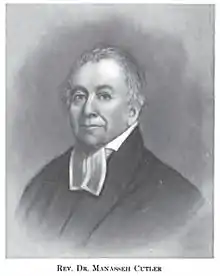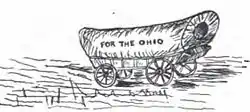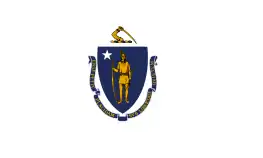Manasseh Cutler
Manasseh Cutler (May 13, 1742 – July 28, 1823) was an American clergyman involved in the American Revolutionary War. He was influential in the passage of the Northwest Ordinance of 1787 and wrote the section prohibiting slavery in the Northwest Territory. Cutler was also a member of the United States House of Representatives. Cutler is "rightly entitled to be called 'The Father of Ohio University.'"[1]

Manasseh Cutler | |
|---|---|
 | |
| Member of the U.S. House of Representatives from Massachusetts | |
| In office March 4, 1801 – March 3, 1805 | |
| Preceded by | Bailey Bartlett (11th) Ebenezer Mattoon (3rd) |
| Succeeded by | William Stedman (11th) Jeremiah Nelson (3rd) |
| Constituency | 11th district (1801–03) 3rd district (1803–05) |
| Personal details | |
| Born | May 13, 1742 Killingly, Connecticut Colony, British America |
| Died | July 28, 1823 (aged 81) Hamilton, Massachusetts, U.S. |
| Political party | Federalist |
| Alma mater | Yale College |
| Military service | |
| Allegiance | |
| Branch/service | |
| Years of service | 1776, 1778 |
| Rank | Chaplain |
| Unit | 11th Massachusetts Regiment |
| Battles/wars | American Revolutionary War |
| Part of a series on |
| Dedham, Massachusetts |
|---|
 |
| History |
| People |
|
| Places |
| Organizations |
| Businesses |
| Education |
Cutler was born in Killingly in the Connecticut Colony. In 1765, he graduated from Yale College and after being a school teacher in Dedham and a merchant – and occasionally appearing in court as a lawyer – he decided to enter the ministry. He married Mary Balch within a year of graduating from Yale.[2] Cutler studied under Mary's father, Thomas Balch, the minister at Dedham's First Church and Parish, for the ministry.[2] From 1771 until his death, he was pastor of the Congregational church in what was the parish of Ipswich, Massachusetts until 1793, now Hamilton.
For a few months in 1776, he was chaplain to the 11th Massachusetts Regiment commanded by Colonel Ebenezer Francis, raised for the defense of Boston. In 1778, he became chaplain to General Jonathan Titcomb's brigade and took part in General John Sullivan's expedition to Rhode Island. Soon after his return from this expedition he trained in medicine to supplement the scanty income of a minister. In 1782, he established a private boarding school, directing it for nearly a quarter of a century.
In 1784 a geological party, headed by Manasseh Cutler, named the highest peak in the northeast Mount Washington.
In 1786, Cutler became interested in the settlement of western lands by American pioneers to the Northwest Territory. The following year, as agent of the Ohio Company of Associates that he had been involved in creating, he organized a contract with Congress whereby his associates (former soldiers of the Revolutionary War) might purchase one and a half million acres (6,000 km²) of land at the mouth of the Muskingum River with their Certificate of Indebtedness. Cutler also took a leading part in drafting the famous Northwest Ordinance of 1787 for the government of the Northwest Territory, which was finally presented to Congress by Massachusetts delegate Nathan Dane. In order to smooth passage of the Northwest Ordinance, Cutler influenced and won the votes of key congressmen by making them partners in his land company. By changing the office of provisional governor from an elected to an appointed position, Cutler was able to offer the position to the president of Congress, Arthur St. Clair.[3] From 1801 to 1805, Cutler was a Federalist representative in Congress.
Cutler was elected a Fellow of the American Academy of Arts and Sciences in 1781.[4] Besides being proficient in the theology, law and medicine of his day, he conducted painstaking astronomical and meteorological investigations and was one of the first Americans to conduct significant botanical research. He is considered a founder of Ohio University and the National Historic Landmark Cutler Hall on that campus is named in his honor. In 1785, Cutler was elected a member of the American Philosophical Society.[5] He received the degree of Doctor of Laws from Yale University in 1789. Manasseh was elected a member of the American Antiquarian Society in 1813.[6]
Cutler died in 1823 at Hamilton, Massachusetts. Three of his descendants were members of the U.S. Congress-and one vice president:
- William P. Cutler [1812-1889] son of Ephraim Cutler
- Rufus Dawes [1838-1899] father of Vice President Charles Gates Dawes and Beman Gates Dawes; he was the son of Mrs. Sarah (Cutler) Dawes daughter of Ephraim Cutler[7]
- Beman Gates Dawes [1870-1953] son of Congressman Rufus Dawes


See also
References
- Life of Manasseh Cutler, Vol. 2, p. 21.
- McCullough, David (May 7, 2019). The Pioneers: The Heroic Story of the Settlers Who Brought the American Ideal West. Simon & Schuster. p. 4. ISBN 978-1-5011-6869-7. Retrieved July 9, 2019.
- McDougall, Walter A. Freedom Just Around the Corner: A New American History, 1585-1828. (New York: Harper Collins, 2004), p. 289.
- "Book of Members, 1780–2010: Chapter C" (PDF). American Academy of Arts and Sciences. Retrieved July 28, 2014.
- "APS Member History". search.amphilsoc.org. Retrieved December 16, 2020.
- American Antiquarian Society Members Directory
- New England Families, Genealogical and Memorial
 This article incorporates text from a publication now in the public domain: Chisholm, Hugh, ed. (1911). "Cutler, Manasseh". Encyclopædia Britannica. 7 (11th ed.). Cambridge University Press. p. 671.
This article incorporates text from a publication now in the public domain: Chisholm, Hugh, ed. (1911). "Cutler, Manasseh". Encyclopædia Britannica. 7 (11th ed.). Cambridge University Press. p. 671.- United States Congress. "Manasseh Cutler (id: C001026)". Biographical Directory of the United States Congress.
External links
- Manasseh Cutler at Ohio History Central
- Cutler, W.P.; Cutler, J.P. (1888). Life Journals and Correspondence of Rev. Manasseh Cutler 2 vols. Cincinnati: Robert Clarke & Company.
- Potts, Louis W. (Summer–Autumn 1987). "Manasseh Cutler, Lobbyist". Ohio History. 96: 101–123.
- Wilson, James Grant; Fiske, John (1887). "Manasseh Cutler". Appleton's Cyclopædia of American Biography. 2. p. 47.
| U.S. House of Representatives | ||
|---|---|---|
| Preceded by Bailey Bartlett |
Member of the U.S. House of Representatives from Massachusetts's 11th congressional district March 4, 1801 – March 3, 1803 |
Succeeded by William Stedman (district moved) |
| Preceded by Ebenezer Mattoon |
Member of the U.S. House of Representatives from Massachusetts's 3rd congressional district March 4, 1803 – March 3, 1805 |
Succeeded by Jeremiah Nelson |

